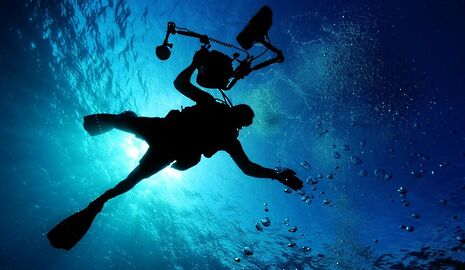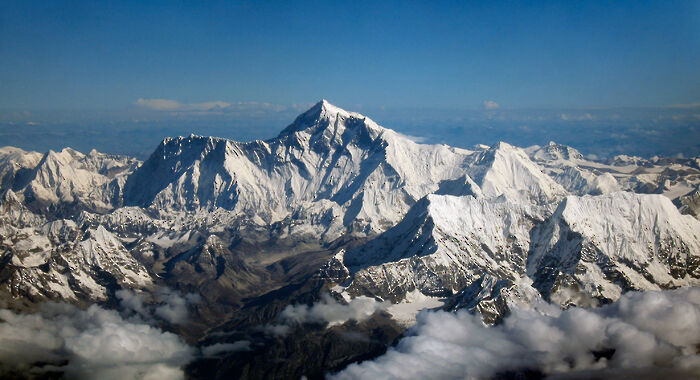How low can we go? The challenges associated with deep sea diving
Despite the many dangers and difficulties associated with plunging deep underwater, it seems that humans consistently maintain an interest in life at the extremes

It is often said that we know more about the surface of the moon than we do about the depths of the oceans. Although each year millions of divers around the world are drawn to descend beneath the surface of lakes, oceans and even swimming pools, the vast majority do not exceed the recommended recreational dive limit of 40m. Yet some have descended far further. These endeavours push the human body close to the combined limits of human physiology and scientific ingenuity. What are the challenges faced by humans who, armed with a wetsuit and breathing apparatus, plunge deeper and deeper? And, just as importantly, what allows them to return to the surface to tell their story?
In contrast to ascent to altitude, the overarching issue faced by divers is a dramatic increase in pressure, with every 10.3m of depth gained adding the equivalent of another atmosphere. The effects of high-pressure nitrogen and oxygen are a primary cause for concern. Nitrogen itself is rather inert, meaning it doesn’t react easily with other substances. However, when its pressure in the body increases, this normally benign gas can produce a condition referred to as nitrogen narcosis. This appears on a sliding scale of severity that includes impaired judgement, euphoria and loss of consciousness. Symptoms typically appear when breathing compressed air at around 50m, with almost all divers being severely affected at 60-70m. The neurological effects of high-pressure nitrogen are more colloquially referred to as ‘Martini’s Law’. Every 10m descended is reported to have the equivalent effect of one martini. The accuracy of this remains to be tested, however, as funding for such a summer research project has surprisingly not been readily forthcoming...
“What are the challenges faced by humans who, armed with a wetsuit and breathing apparatus, plunge deeper and deeper?”
Nitrogen narcosis can be avoided, however, by replacing nitrogen with non-narcotic helium in a mixture creatively termed Heliox. As helium is much lighter than molecular nitrogen, this also increases the ease of breathing, which gets more difficult at depth. As such, there is also particular interest in using Heliox for conditions such as asthma and lung disease, although cost currently limits this clinical use.
Returning for a moment to the recreational dive limit of 40m, it is not only nitrogen that divers should start to be wary of. At high pressures oxygen itself becomes toxic, though unlike in the case of nitrogen, this toxicity is due to chemical reactions which it undergoes in the body. It is recommended that long term exposure to oxygen is limited to about 2-2.5 times atmospheric oxygen pressure, or that which is found when breathing compressed air at 10-15m. This limit mainly poses an issue for professional divers working on long-term projects.
On the other hand, if you breathe compressed air at greater depths, oxygen toxicity can occur far more rapidly. Neurological symptoms leading to convulsions and unconsciousness occur in under five minutes in susceptible individuals at around 70m. For longer, deeper descents, it is therefore dangerous to use standard compressed air, and the concentration of oxygen supplied by breathing apparatus is reduced significantly.
Descend past around 120m, and the susceptibility of the nervous system to high pressure starts to pose an issue. High pressure can cause tremors, exaggerated reflexes, muscle weakness and hallucinations, among a constellation of symptoms termed high pressure neurological syndrome (HPNS). This is thought to be caused by altered ion channel function in the nervous system as opposed to compression of non-gaseous components of the body which only starts to become noticeable at depths of around 1500m. In contrast to nitrogen narcosis, the overall syndrome is one of excess excitability. As such, it has been suggested that reintroduction of a small amount of nitrogen into diving cannisters could mitigate against HPNS effects by inducing a degree of mild, compensatory nitrogen narcosis.
However, reaching record-breaking depths is only the first half of the challenge. Ascent to the surface carries additional risks, the most recognised of which is decompression sickness (DCS), also known as “the bends”. As pressure increases upon ascent, even poorly soluble gases such as nitrogen are forced to dissolve more extensively in the body. The amount of dissolved gas depends both on depth and, up to a threshold, the amount of time spent at each pressure. Return too quickly to the surface and a diver rapidly removes the pressure keeping gases dissolved. This can result in the potentially lethal formation of bubbles, most notably in the blood vessels of the brain and heart.
“What is certain is that humans consistently maintain an interest in life at the extremes”
Accordingly, ascents from deeper, longer dives include decompression stops in which a diver remains at a certain depth for a short period of time to allow dissolved gases to move out of the body more slowly. Dive deeper and the decompression stops required become longer and longer. Ahmed Gabr’s record breaking SCUBA diving descent of 332.25m involved spending over 14 hours in the water. The time required for decompression following long, deep professional dives makes it impractical to ascend each day and technical crews in the oil and gas industry can live for days in artificially pressurised living quarters to avoid the daily necessity.
Yet evidence suggests that humans can dive even deeper. In 2006 a US Navy diver descended to a depth of 610m in a specially designed atmospheric diving suit offering protection from high pressure. Furthermore, in 2010 the Hydra research program in Marseille saw three divers exposed to artificial pressures equivalent to a depth of 701m. They breathed a novel mixture of hydrogen, helium and oxygen shown to reduce the effects of pressure on the nervous system and increase the ease of breathing. Recreational divers weary of their own decompression stops should take note of the 24 days of decompression that the three divers underwent before their return to the outside world.
In contrast, in the sport of free diving, it is the rapid speed of descent and ascent rather than decompression stops and specialist breathing apparatus that protect against nitrogen narcosis, oxygen toxicity and decompression sickness. Nevertheless, it is perhaps surprising that the no limits free diving record set by Herbert Nitsch in 2012 with a single breath stands at 253.2m, less than 80m off the record for SCUBA diving.
Just as naval captains don’t know exactly how deep their submarines can really go, it is not possible to state an absolute limit for human diving in the absence of pressure-controlling suits. Yet what is certain is that humans consistently maintain an interest in life at the extremes. Where there are records to be broken and theories to be tested, it would be more surprising still if people weren’t up for the challenge.
 Comment / Plastic pubs: the problem with Cambridge alehouses 5 January 2026
Comment / Plastic pubs: the problem with Cambridge alehouses 5 January 2026 News / Cambridge academics stand out in King’s 2026 Honours List2 January 2026
News / Cambridge academics stand out in King’s 2026 Honours List2 January 2026 News / Cambridge businesses concerned infrastructure delays will hurt growth5 January 2026
News / Cambridge businesses concerned infrastructure delays will hurt growth5 January 2026 News / AstraZeneca sues for £32 million over faulty construction at Cambridge Campus31 December 2025
News / AstraZeneca sues for £32 million over faulty construction at Cambridge Campus31 December 2025 Interviews / You don’t need to peak at Cambridge, says Robin Harding31 December 2025
Interviews / You don’t need to peak at Cambridge, says Robin Harding31 December 2025










